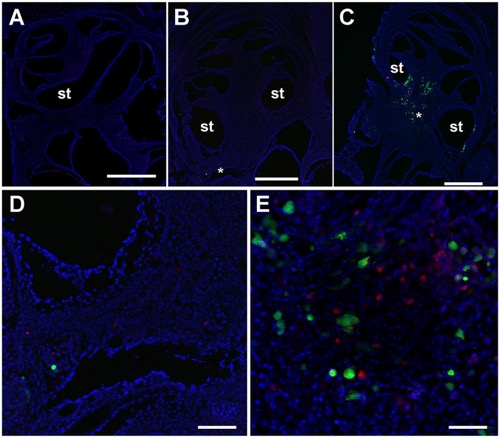Natural killer cells recognize and bind to viral protein on surface of infected inner ear cells.

To determine the significance of the interaction between NK cells and m157, Ali Almishaal of the University of Utah College of Health and colleagues performed experiments in mice. They used previously developed techniques to mimic many of the features of CMV-induced hearing loss in children.
The researchers used mice bred to lack a functional version of the protein Ly49H, a receptor protein found on the surface of NK cells that recognizes and binds to m157. After infection with CMV, these mice developed profound hearing loss and lost a significant amount of outer hair cells, which are found in the ear and play an important role in hearing. In contrast, CMV-infected mice with functional Ly49H had minimal loss of hearing and hair cells.
To further confirm the importance of the interaction between Ly49H and m157, the research team used an antibody to block Ly49H activity in a third group of CMV-infected mice. They also infected a fourth group with a CMV strain lacking the gene that codes for m157. Both groups were more susceptible to hearing loss than mice with normal Ly49H/m157 interaction.
These results confirm the importance of the Ly49H/m157 interaction in protecting against hearing loss in CMV-infected mice. This interaction was previously shown to play an important role in protecting against CMV effects in the mouse spleen and lung, but is less effective in the liver.
While their findings provide new insights into the mechanisms of CMV-induced hearing loss, the authors say that efforts to prevent hearing loss by targeting NK cell activity are unlikely to be successful without far better understanding of NK cell activity in utero and in newborns.
"The study demonstrates the importance of the innate immune response in controlling CMV-induced hearing loss. We expect that further characterization of this response will ultimately lead to identification of novel effective clinical interventions." Albert Park, MD, the study's senior author adds.
###
Article freely available in PLOS Pathogens: https://journals.
Citation: Almishaal AA, Mathur PD, Hillas E, Chen L, Zhang A, Yang J, et al. (2017) Natural killer cells attenuate cytomegalovirus-induced hearing loss in mice. PLoS Pathog 13(8): e1006599. https:/
Funding: This work was supported in part by a 2013 Career Development Award from the Triological Society (https://www.
Source: https://www.eurekalert.org/pub_releases/2017-09/p-isc092817.php

